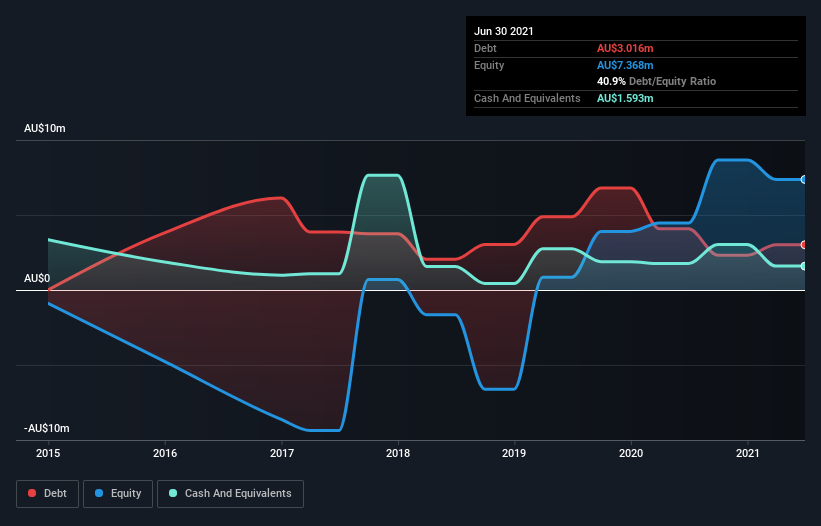
David Iben put it well when he said, 'Volatility is not a risk we care about. What we care about is avoiding the permanent loss of capital.' So it might be obvious that you need to consider debt, when you think about how risky any given stock is, because too much debt can sink a company. We note that engage:BDR Limited (ASX:EN1) does have debt on its balance sheet. But should shareholders be worried about its use of debt?
What Risk Does Debt Bring?
Debt assists a business until the business has trouble paying it off, either with new capital or with free cash flow. Part and parcel of capitalism is the process of 'creative destruction' where failed businesses are mercilessly liquidated by their bankers. While that is not too common, we often do see indebted companies permanently diluting shareholders because lenders force them to raise capital at a distressed price. Of course, plenty of companies use debt to fund growth, without any negative consequences. The first thing to do when considering how much debt a business uses is to look at its cash and debt together.
See our latest analysis for engage:BDR
What Is engage:BDR's Net Debt?
As you can see below, engage:BDR had AU$3.02m of debt at June 2021, down from AU$4.08m a year prior. However, because it has a cash reserve of AU$1.59m, its net debt is less, at about AU$1.42m.

A Look At engage:BDR's Liabilities
According to the last reported balance sheet, engage:BDR had liabilities of AU$7.17m due within 12 months, and liabilities of AU$149.7k due beyond 12 months. Offsetting these obligations, it had cash of AU$1.59m as well as receivables valued at AU$6.16m due within 12 months. So it can boast AU$432.4k more liquid assets than total liabilities.
This short term liquidity is a sign that engage:BDR could probably pay off its debt with ease, as its balance sheet is far from stretched. The balance sheet is clearly the area to focus on when you are analysing debt. But it is engage:BDR's earnings that will influence how the balance sheet holds up in the future. So if you're keen to discover more about its earnings, it might be worth checking out this graph of its long term earnings trend.
In the last year engage:BDR had a loss before interest and tax, and actually shrunk its revenue by 21%, to AU$15m. To be frank that doesn't bode well.
Caveat Emptor
While engage:BDR's falling revenue is about as heartwarming as a wet blanket, arguably its earnings before interest and tax (EBIT) loss is even less appealing. Indeed, it lost a very considerable AU$3.9m at the EBIT level. Looking on the brighter side, the business has adequate liquid assets, which give it time to grow and develop before its debt becomes a near-term issue. But we'd want to see some positive free cashflow before spending much time on trying to understand the stock. So it seems too risky for our taste. There's no doubt that we learn most about debt from the balance sheet. But ultimately, every company can contain risks that exist outside of the balance sheet. For example engage:BDR has 4 warning signs (and 2 which are a bit unpleasant) we think you should know about.
At the end of the day, it's often better to focus on companies that are free from net debt. You can access our special list of such companies (all with a track record of profit growth). It's free.
If you're looking to trade Colortv, open an account with the lowest-cost platform trusted by professionals, Interactive Brokers.
With clients in over 200 countries and territories, and access to 160 markets, IBKR lets you trade stocks, options, futures, forex, bonds and funds from a single integrated account.
Enjoy no hidden fees, no account minimums, and FX conversion rates as low as 0.03%, far better than what most brokers offer.
Sponsored ContentNew: AI Stock Screener & Alerts
Our new AI Stock Screener scans the market every day to uncover opportunities.
• Dividend Powerhouses (3%+ Yield)
• Undervalued Small Caps with Insider Buying
• High growth Tech and AI Companies
Or build your own from over 50 metrics.
Have feedback on this article? Concerned about the content? Get in touch with us directly. Alternatively, email editorial-team (at) simplywallst.com.
This article by Simply Wall St is general in nature. We provide commentary based on historical data and analyst forecasts only using an unbiased methodology and our articles are not intended to be financial advice. It does not constitute a recommendation to buy or sell any stock, and does not take account of your objectives, or your financial situation. We aim to bring you long-term focused analysis driven by fundamental data. Note that our analysis may not factor in the latest price-sensitive company announcements or qualitative material. Simply Wall St has no position in any stocks mentioned.
About ASX:CTV
Colortv
Colortv Limited operates as an Internet-based marketplace platform and technology solution provider in the United States and internationally.
Mediocre balance sheet and slightly overvalued.
Market Insights
Community Narratives




